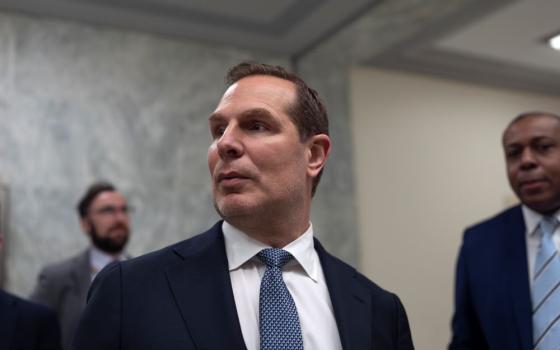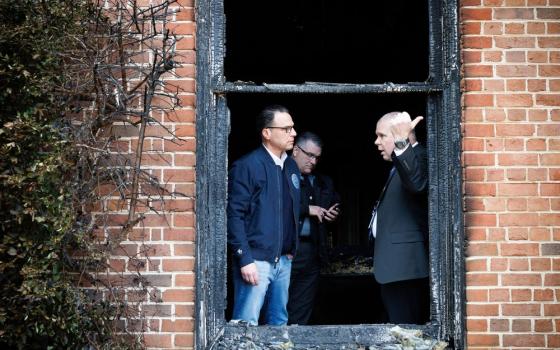The letters — sent May 18 to every parish in the Diocese of Peoria, Illinois, bearing Pentecost greetings from Bishop Louis Tylka — were expected. For some of the diocese's faith communities, they contained news that was a relief; for others, a confirmation of their fears.
After a two-year planning process christened "Growing Disciples," Tylka announced the diocese's 156 parishes will become 75 parishes with 129 "worship sites." Twelve parishes will merge into neighboring parishes, while another 107 parishes will merge to create 38 new ones.
Decisions will be implemented on July 1, with a three-year period envisioned to complete the new canonical structures. Parishes with no planned structural changes are nonetheless asked to evaluate their Mass schedules, pastoral care, and evangelization efforts.
"It is important that we understand our current difficulties," Tylka — often referred to as "Bishop Lou" — said in an eight-plus minute video message.
"There are, at present, 145 active priests," he said, pointing out that they serve urban, suburban and rural parishes across 17,000 square miles. "However, our priests are aging and the projection is that within the next 10 years we will have fewer than 100 active priests."
A shortage of priests — 70% of whom are over the age of 50 — Tylka noted, is not the only challenge faced by the diocese.
"The demographics of our diocese continue to change overall, with 49% fewer people in our parishes over the last decade," he added.
According to the diocese, approximately 11% of the 1.4 million people living within the diocese's boundaries, are Catholic.
Diocesan figures are indeed stark: Mass attendance is down 19% from 2011-2019, and an additional 22% from 2019-2022. Since 2015-2016, infant baptisms have fallen 27%; funerals, 10%; and Catholic marriages, 34%.
Those trends, Tylka said, "reflect the national landscape, as they are half of what they were 20 years ago."
Data from Georgetown University's Center for Applied Research in the Apostolate — a research center that conducts social scientific studies about the Catholic Church — echoes Tylka's assertion that the Peoria Diocese isn't a statistical anomaly.
"We find ourselves with fewer people, fewer priests, fewer resources," Tylka summarized in his video message, while also proclaiming "a greater responsibility to respond to the call of the Gospel anew."
The weight of the eventual decisions, Tylka shared, has "been heavy on my mind and heart."
The facade of St. Mary's Cathedral in Peoria, Ill., is seen Sept. 28, 2017. The Diocese of Peoria announced May 18, 2024, massive restructuring plans that would merge its existing 156 parishes into 75 parishes with 129 "worship sites." (OSV News/Tom Dermody, The Catholic Post)
"It's a geographically framed situation," Jesuit Father Thomas Gaunt, CARA's executive director, told OSV News.
"In the Northeast and Midwest, there has been a decline in the Catholic population overall. And in the South and West, there's been enormous growth. Kids grow up in the Northeast or Midwest, go to school and get a great job in Atlanta or Houston or Phoenix," Gaunt noted. "And also with the immigrant stream, people come to the United States, and they go where the jobs are."
"It's internal movement and external immigration that creates this situation," he added. "In Peoria, there's been a notable decline in the number of Catholics in the diocese, overall, over the years. So with that, they're reconfiguring parishes so that they can continue to have vibrant and vital communities — instead of just kind of getting smaller and smaller and cutting back more and more, parish after parish."
Populations have declined in regions like Central Illinois, and are not replenishing. The city of Peoria's population decreased -3.24% since the most recent census, which recorded 112,850 citizens in 2020.
"This is in general," emphasized Gaunt. "it's not just the Catholic community, but overall."
Parishes once built to serve a larger population are faced with increasingly empty pews.
"People move, but buildings don't — and it's hard to get around that," Gaunt reflected. "This has occurred across the United States, generation after generation. It's not unique. You have areas where there was a booming economy and population, and then decline."
Gaunt stressed the importance of viewing the changes in context.
"I think the danger is, if you're a pastor in Peoria, you can look out and say, 'My gosh, what have I done wrong? The people aren't showing up.' Well, you didn't do anything wrong," he said. "It may be quite the opposite — you did everything correct. You had a community with great schools and opportunities, and people took advantage of them."
Advertisement
While Tylka commented in his video message that "numbers do not tell the whole story," they do necessarily impact parish operations and worship.
"There's a very basic level where, in a given parish, you need 'X' number of families in order to have a sufficient number of people assisting with the lay ministries; a sufficient number of people to have a vibrant religious education program for the children; enough people to have a choir," observed Gaunt. "Those things can be better accomplished if you have 500 or 800 families, as opposed to 100 families."
Five "foundations" have been discerned "on which to build the future of the Diocese of Peoria" — evangelization; discipleship; vocations; awareness of Christ's presence in the Eucharist; and the legacy of Archbishop Fulton Sheen.
Fulton J. Sheen — who remains on the path to sainthood — was ordained a priest of the Diocese of Peoria at St. Mary's Cathedral on Sept. 20, 1919. He eventually became an auxiliary bishop of the New York Archdiocese, was briefly bishop of the Diocese of Rochester, New York, and later made a titular archbishop. A prolific writer, Sheen was known particularly for his radio and television evangelization.
After a three-year legal battle, the prelate's remains were in 2019 removed from St. Patrick's Cathedral in New York City and reinterred at St. Mary's Cathedral in Peoria in order to accomplish his beatification. However, that step was postponed later that year in response to the New York attorney general's investigation into the historic handling of sexual abuse cases by New York dioceses, which would also include Sheen's three years as bishop in Rochester.
The Peoria Diocese also hosts a museum dedicated to Sheen's legacy.
Tylka declared he is "convinced that we are moving in the right direction to a more vibrant, mission-driven and sustainable church to grow disciples for generations to come!"
Concluding his video message, he struck an optimistic tone.
"These difficult and yet necessary changes," Tylka said, "will create greater freedom to engage in this new apostolic age."







